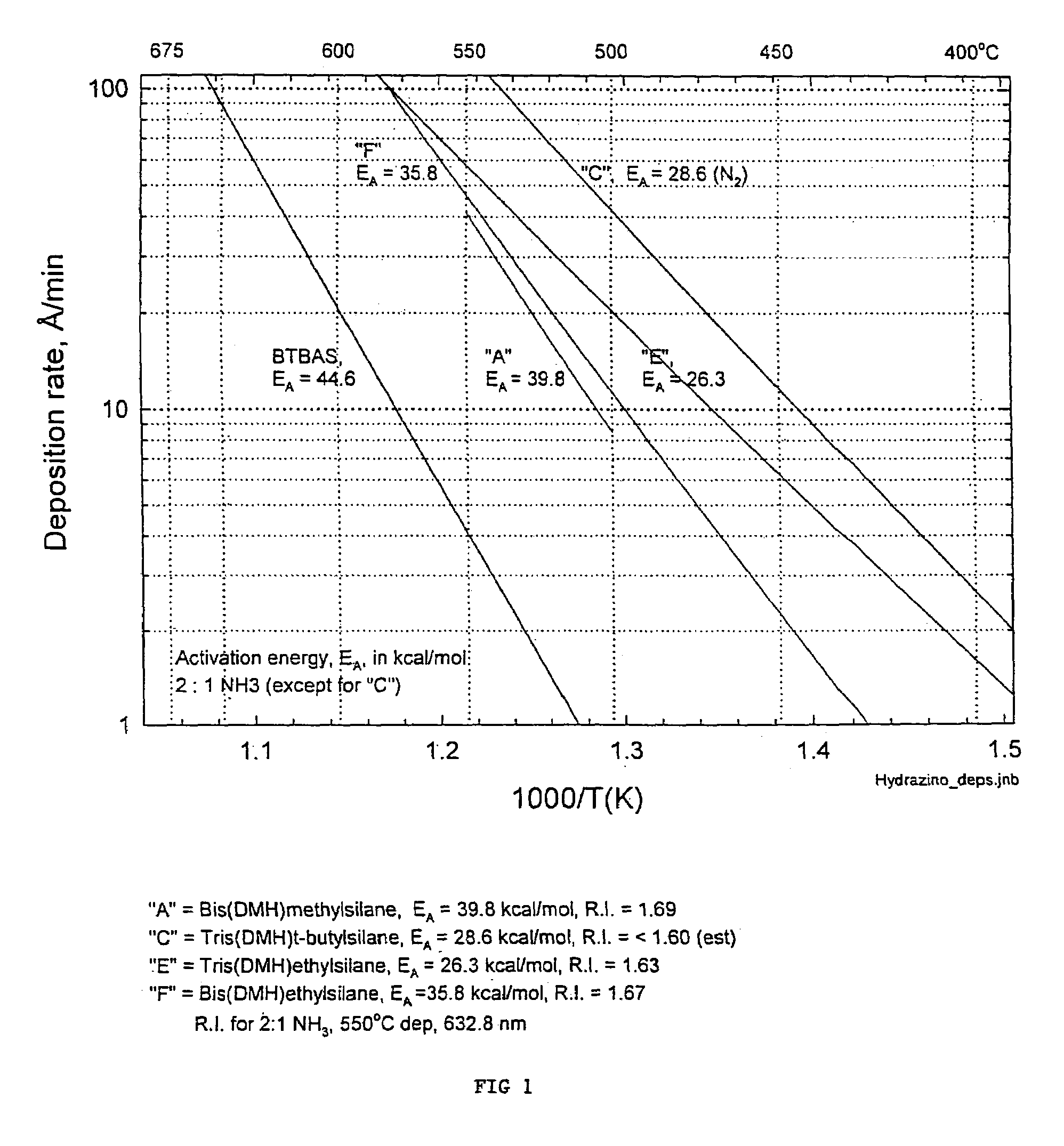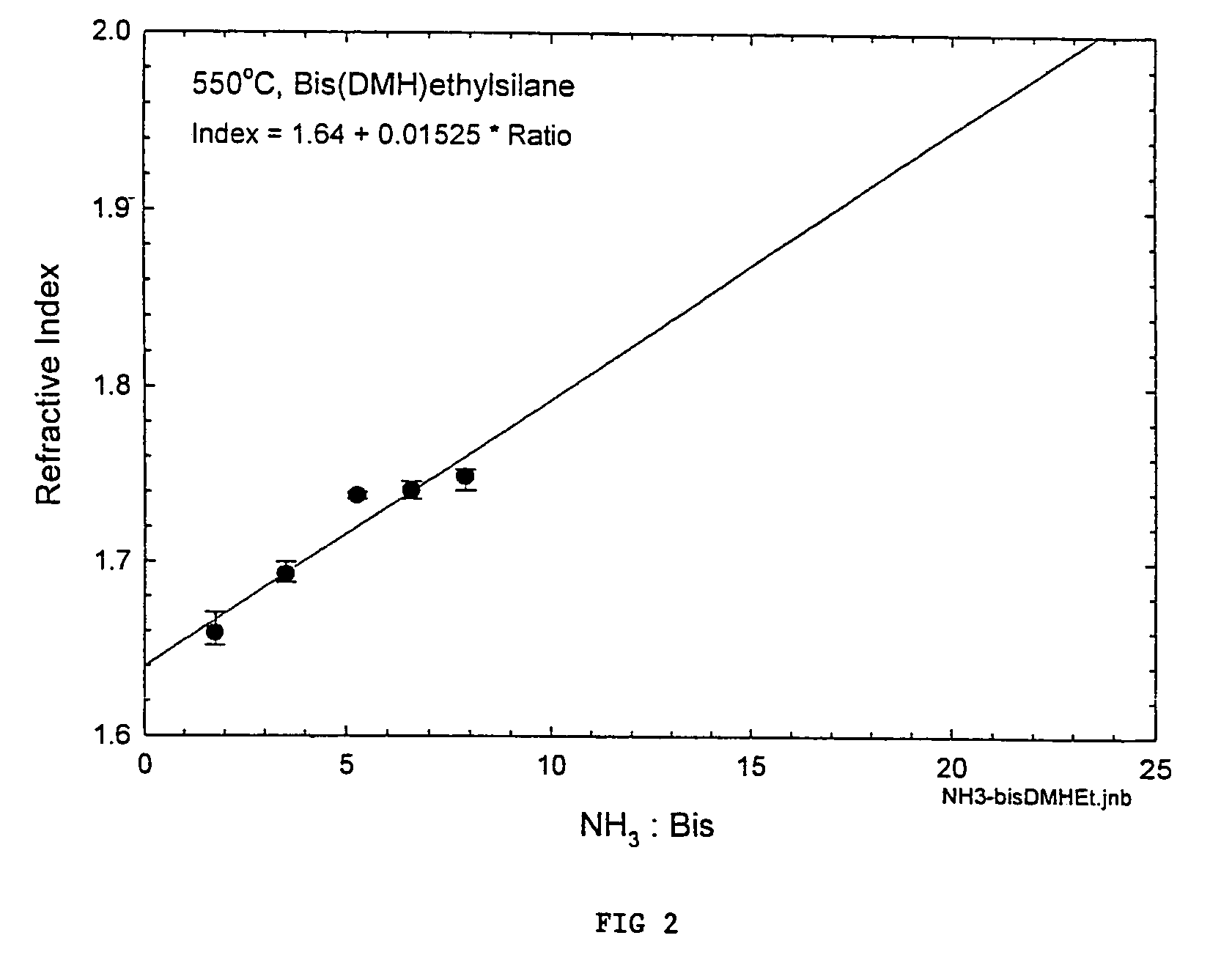Precursors for depositing silicon containing films and processes thereof
- Summary
- Abstract
- Description
- Claims
- Application Information
AI Technical Summary
Benefits of technology
Problems solved by technology
Method used
Image
Examples
example 1
Synthesis of Bis(1,1-dimethylhydrazino)methylsilane
[0072]In a 2000 ml three-neck round bottom flask equipped with two addition funnels, a condenser, and a mechanical stirrer, 500 ml of hexane and 303 g of triethylamine were added. With the cooling of an ice bath and protection of nitrogen atmosphere, a solution of 115 g methyldichlorosilane in 100 ml hexane and a solution of 150 g 1,1-dimethylhydrazine in 50 ml hexane were added through two addition funnels at about equal rates. The reaction mixture was then allowed to warm to room temperature and stirred overnight. In nitrogen atmosphere, the reaction mixture was filtered and the solid amine salt was washed with hexane. The solvent and excess amines were removed by vacuum distillation. Vacuum distillation produced 125 g of Bis(1,1-dimethylhydrazino) methylsilane, boiling point 45° C. / 22 Torr.
example 2
Synthesis of Bis(1,1-dimethylhydrazino)ethylsilane
[0073]In a 5000 ml three-neck round bottom flask equipped with two addition funnels, a condenser, and a mechanical stirrer, 1500 ml of hexane and 450 g of triethylamine were added. With the cooling of an ice bath and protection of nitrogen atmosphere, a solution of 200 g ethyltrichlorosilane in 500 ml hexane and 196 g 1,1-dimethylhydrazine were added through two addition funnels at about equal rates. The reaction mixture was then allowed to warm to room temperature and stirred overnight. In nitrogen atmosphere, the reaction mixture was filtered and the solid amine salt was washed with hexane. The solvent and excess amines were removed by vacuum distillation. Vacuum distillation produced 154 g of Bis(1,1-dimethylhydrazino)ethylsilane, boiling point 40° C. / 10 Torr.
example 3
Synthesis of Tris(1,1-dimethylhydrazino)-t-butylsilane
[0074]In a 2000 ml three-neck round bottom flask equipped with two addition funnels, a condenser, and a mechanical stirrer, 800 ml of hexane and 125 g of triethylamine were added. With the cooling of an ice bath and protection of nitrogen atmosphere, a solution of 48 g t-butyltrichlorosilane in 100 ml hexane and a solution of 50 g 1,1-dimethylhydrazine in 100 ml hexane were added through two addition funnels at about equal rates. The reaction mixture was then allowed to warm to room temperature and stirred overnight. In nitrogen atmosphere, the reaction mixture was filtered and the solid amine salt was washed with hexane. The solvent and excess amines were removed by vacuum distillation. Vacuum distillation produced 30 g of Tris(1,1-dimethylhydrazino)-t-butyllsilane, boiling point 56° C. / 2 Torr. 1H NMR 1.19 (s, 9H), 2.34 (s, 18H).
PUM
| Property | Measurement | Unit |
|---|---|---|
| Temperature | aaaaa | aaaaa |
| Pressure | aaaaa | aaaaa |
| Pressure | aaaaa | aaaaa |
Abstract
Description
Claims
Application Information
 Login to View More
Login to View More - R&D
- Intellectual Property
- Life Sciences
- Materials
- Tech Scout
- Unparalleled Data Quality
- Higher Quality Content
- 60% Fewer Hallucinations
Browse by: Latest US Patents, China's latest patents, Technical Efficacy Thesaurus, Application Domain, Technology Topic, Popular Technical Reports.
© 2025 PatSnap. All rights reserved.Legal|Privacy policy|Modern Slavery Act Transparency Statement|Sitemap|About US| Contact US: help@patsnap.com



